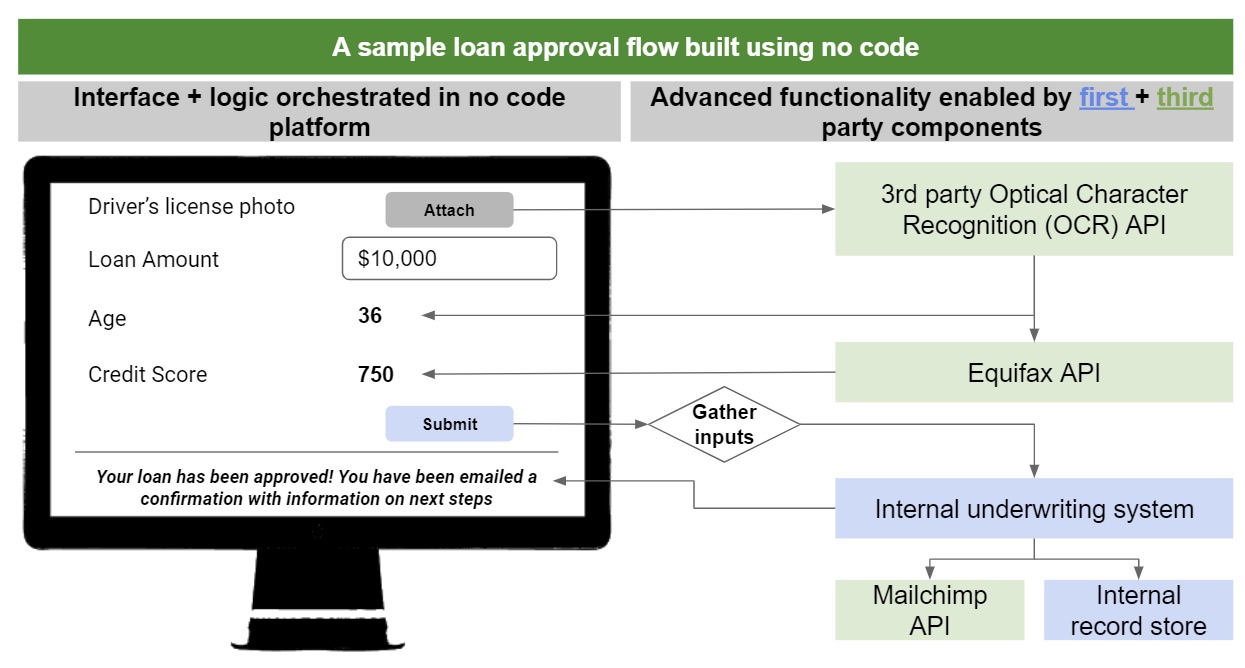It seems like every software funding and product announcement these days includes some sort of reference to “no code” platforms or functionality. The frequent callbacks to this buzzy term reflect a realization that we’re entering a new software era.
Similar to cloud, no code is not a category itself, but rather a shift in how users interface with software tools. In the same way that PCs democratized software usage, APIs democratized software connectivity and the cloud democratized the purchase and deployment of software, no code will usher in the next wave of enterprise innovation by democratizing technical skill sets. No code is empowering business users to take over functionality previously owned by technical users by abstracting complexity and centering around a visual workflow. This profound generational shift has the power to touch every software market and every user across the enterprise.
The average enterprise tech stack has never been more complex
In a perfect world, all enterprise applications would be properly integrated, every front end would be shiny and polished, and internal processes would be efficient and automated. Alas, in the real world, engineering and IT teams spend a disproportionate share of their time fighting fires in security, fixing internal product bugs and running vendor audits. These teams are bursting at the seams, spending an estimated 30% of their resources building and maintaining internal tools, torpedoing productivity and compounding technical debt.
Seventy-two percent of IT leaders now say project backlogs prevent them from working on strategic projects. Hiring alone can’t solve the problem. The demand for technical talent far outpaces supply, as demonstrated by the fact that six out of 10 CIOs expect skills shortages to prevent their organizations from keeping up with the pace of change.
At the same time that IT and engineering teams are struggling to maintain internal applications, business teams keep adding fragmented third-party tools to increase their own agility. In fact, the average enterprise is supporting 1,200 cloud-based applications at any given time. Lacking internal support, business users bring in external IT consultants. Cloud promised easy as-needed software adoption with seamless integration, but the realities of quickly changing business needs have led to a roaring comeback of expensive custom software.
According to Forrester Research, enterprise expenditure on custom software is on track to double from $250 billion in 2015 to $500 billion in 2020. This is coming at the price of not only hefty consulting fees, but also impaired enterprise agility and inefficient, siloed workflows. This explosion of demand for custom applications represents the perfect opportunity for no code to capture spend that would otherwise flow to services.
No code dramatically increases the addressable user base of technical software
No code functionality is an ideal mechanism to address these pain points by enabling nontechnical users to build, configure and maintain software while also making technical users more efficient. As a new class of user interface, no code enables users to design or configure software with a visual workflow, removing the need for programming know-how and abstracting other technical complexities (e.g., API integrations, data mapping, etc.). No code is a horizontal shift far broader than a new category and will be adopted wherever there exists both technical complexity to be abstracted and resource constraints associated with the workflow.
Low code and no code are often mentioned interchangeably, but, despite sitting on the same continuum, the concepts are distinct. While both low code and no code abstract underlying code and technicality, low code aims to make developers more efficient with limited abstraction while no code aims to empower both developers and nontechnical users through robust abstraction. While the currently addressable use cases of each vary slightly, the trends driving adoption of each are enough aligned that this piece focuses on no code as the logical extreme of the movement.
The concept of no code has been around for decades. Excel is one of the earliest and most broadly used no code tools in existence (John Collison from Stripe recently articulated this.) There have also been other popular tools like Visual Basic and various WYSIWYG editors. While the concept behind no code is certainly not new, what is new is the widespread adoption of no code within the enterprise. According to Forrester Research, 84% of enterprises have started using low code/no code technology, and Gartner predicts that low code/no code will represent 65% of all app development by 2024. This shift in adoption has been catalyzed both by accelerating constraints and cultural shifts within IT departments, as well as technical shifts enhancing the functionality of no code platforms.
First, siloed cloud apps are sprawling out of control. As workflows span an increasing number of tools, they are arguably getting more manual. Business users have been forced to map workflows to the constraints of their software, but it should be the other way around. They need a way to combat this fragmentation with the power to build integrations, automations and applications that naturally align with their optimal workflows.
Second, architecturally, the ubiquity of cloud and APIs enable “modular” software that can be created, connected and deployed quickly at little cost composed of building blocks for specific functions (such as Stripe for payments or Plaid for data connectivity). Both third-party API services and legacy systems leveraging API gateways are dramatically simplifying connectivity. As a result, it’s easier than ever to build complex applications using pre-assembled building blocks. For example, a simple loan approval process could be built in minutes using third-party optical character recognition (a technology to convert images into structured data), connecting to credit bureaus and integrating with internal services all via APIs. This modularity of best-of-breed tools is a game changer for software productivity and a key enabler for no code.

Image Credits: CapitalG (opens in a new window)
Finally, business leaders are pushing CIOs to evolve their approach to software development to facilitate digital transformation. In prior generations, many CIOs believed that their businesses needed to develop and own the source code for all critical applications. Today, with IT teams severely understaffed and unable to keep up with business needs, CIOs are forced to find alternatives. Driven by the urgent business need and assuaged by the security and reliability of modern cloud architecture, more CIOs have begun considering no code alternatives, which allow source code to be built and hosted in proprietary platforms.
That isn’t to say there hasn’t been resistance to no code. Many IT leaders have resisted no code over the years due to fears of security risks, loss of control for code used within their departments, challenges integrating core systems and the potential manipulation of sensitive data and critical systems by business users. These are all reasonable concerns, but the tailwinds are shifting, and we’ve seen increased openness to no code within the last few years. Whereas only a few years ago, many IT leaders considered business-led IT to be a risk (Gartner, 2014), today many of those same leaders consider this trend to be a strategic lever to be embraced (Gartner, 2019). They’ve decided, as have we, that if executed properly, no code can foster more efficient collaboration between business and IT in a way that simultaneously addresses the needs of both. Just as we saw with the rise of public cloud, we believe that no code’s clear ROI will overwhelmingly outweigh the costs of relinquishing some control over infrastructure. No code is another step along the journey of “infrastructure” abstraction in favor of higher efficiency and lower surface area for maintenance or errors.
Solving key pain points that plague most enterprises
Early no code winners are succeeding by focusing on specific functional or vertical use cases. By focusing on specific top-of-mind problems, these vendors have been able to deliver fast time-to-value for customers and achieve product-market fit. The successful early no code winners are finding success by delivering two main advantages to enterprises:
- Higher velocity: Innovative no code companies are enabling enterprises to respond to competition and customer needs by launching new digital products quickly, without relying on overtaxed engineering and IT resources. Example: Using Unqork*, a no code application development platform, a business unit within a top 10 global bank launched a new wealth management product in only three months. Their internal IT team had estimated that it would have taken them two years to get to it. Another example, using Webflow, a no code web design tool, a major technology company enabled their team of 100 designers to assemble and launch fully functioning websites without using any external design agencies.
- Greater operational efficiency: Additional no code companies are empowering operational teams to build and automate processes so that they can respond to customer needs faster and boost team productivity. Example: A global media company deployed UiPath* to accelerate digital transformation and free up employees from being the “glue” between systems, saving 350,000 hours in the first year across 20+ organizational units. Using BRYTER, a global law firm has empowered thousands of lawyers to encode specific areas of legal knowledge to both automate repetitive internal tasks and build custom tools for clients. The firm’s clients are thrilled with the new products, and the law firm is able to dedicate its knowledge workers to the firm’s toughest and highest-value problems.
No code disruptors will drive the coming generational shift
Software categories evolve in generations. In the same way that the cloud has defined the current generation, no code will define the next generation, displacing long-standing incumbents and creating new categories with its dual promise of higher velocity coupled with lower costs. This shift will be most powerful in areas where the urgency for better software (driven by business needs) intersects with capacity constraints for technical users.
Looking at software spend by category we identified ~$285 billion of current spending on categories with the potential for no code entrants to capture a meaningful share of existing budgets. This includes categories like analytics, application development, IT operations and integration and middleware.
This fundamental shift provides an opening for a new cohort of no code companies to grow into the next generation of software powerhouses. The most successful no code products will embrace it as a new abstraction layer structured around how people think rather than simply a visual syntax layer masking the same process steps of writing code. This fundamental rethinking of business processes will be necessary to truly scale functionality to nontechnical users. Perhaps the most exciting hope for no code is that it will democratize the technical skills key to building modern businesses and enable a new ecosystem of standalone companies and enterprise business units built on diverse, high-quality ideas regardless of their teams’ access to technical firepower.
Despite the growing buzz and momentum, we’re still in the very early innings of no code, especially within the enterprise. We are excited to see a strong cohort of burgeoning no code companies being formed and can’t wait to see how creative entrepreneurs will leverage its potential to drastically improve our most basic interactions with software. For most IT groups and business users, no code can’t come soon enough.
*Unqork and UiPath are CapitalG portfolio companies.
**Special thanks to Jeremy Zhu for his collaboration on this article.
